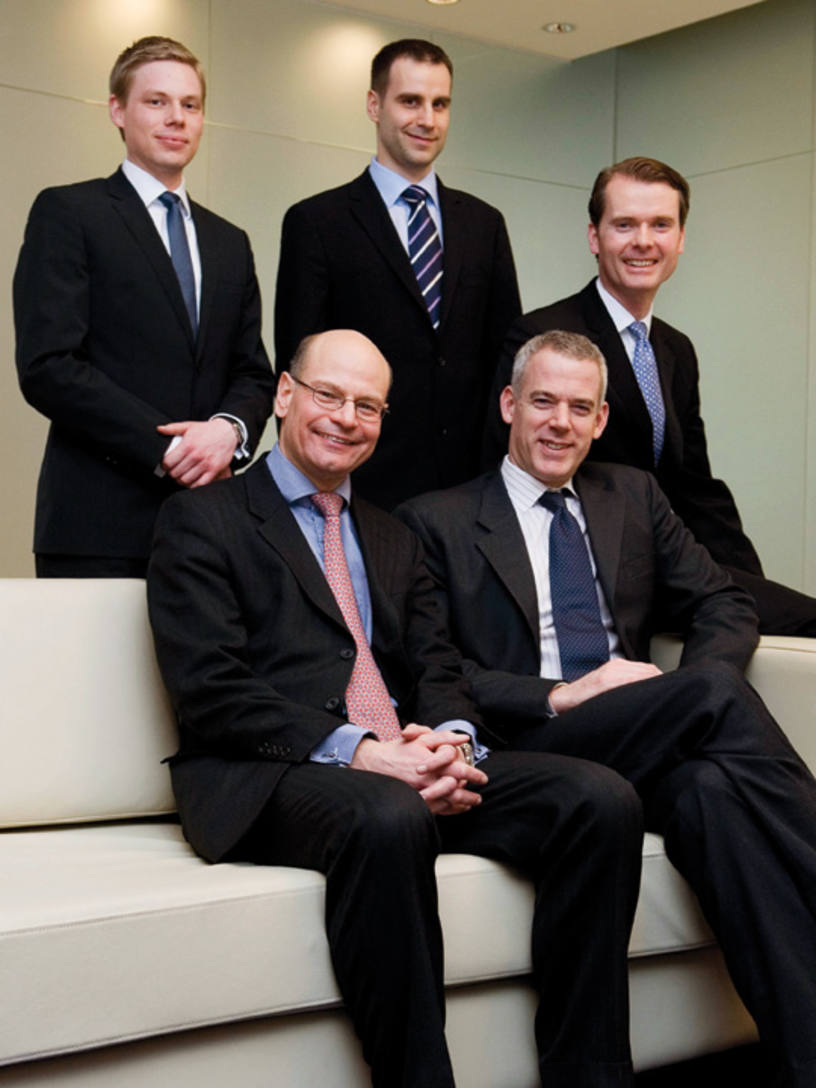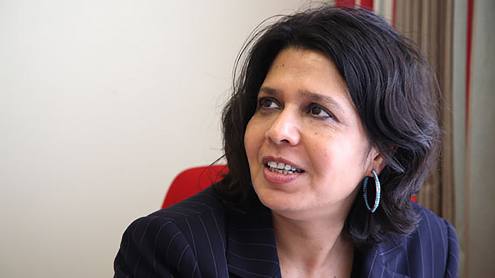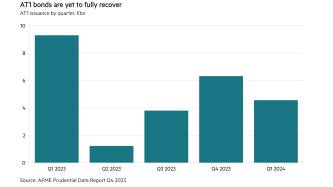The past two years have been busy ones for bankers specialising in European corporate liability management, with bond buybacks setting new records. Yet German companies have been conspicuously absent from the scene, believing as they do that buying bonds back from the market is just too difficult. German power utility E.ON has now turned that theory on its head by completing the largest ever buyback in the European corporate bond market.
As the company attempts to energise its languishing share price, it has been refocusing its international strategy, making various divestments. One was the sale of Louisville Gas and Electric and Kentucky Utilities (acquired when the company bought Powergen of the UK in 2002) for $7.625bn. It also offloaded its remaining 3.5% stake in Russian energy company Gazprom, after a row over gas pricing, for €3.4bn. It intends to make further European disposals, totalling a possible €15bn.
The plan is to increase its exposure to higher-margin, non-regulated businesses outside Europe. At the same time, E.ON is determined to retain its A credit rating, downgraded from AA- in 2009, when it raised large amounts of debt. It was in that context that the company had to ask itself what it should do with some of the cash raised from disposals. After discussions in late 2010 with bankers from Royal Bank of Scotland (RBS) and Bank of America Merrill Lynch (BAML), it chose the distinctly un-German course of buying back some of its outstanding bonds.
Lop-sided profile
The market has had a rather lop-sided profile. “The calendar years 2009 and 2010 were extremely active in liability management, globally and in Europe, involving both corporates and financial institutions,” says Andrew Burton, head of liability management at RBS, which was joint structuring bank and joint dealer manager on the buyback alongside BAML.
“Corporate balance sheets and cash flows have been extremely strong, but companies have not really been investing because they are still scared of the world out there. So what do they do? Given continuing sovereign concerns, it’s a sensible trade to reduce your debt,” says Mr Burton.
With interest rates at their present level, the trend has been to issue long and buy back short. In 2010, corporate bonds worth the equivalent of €58bn were targeted in European liability management transactions, with €16bn of that – or 28% – coming back to its issuers. French issuers accounted for an extraordinary €42bn and €10bn of those totals. No one is quite sure why liability management has set France alight but it has clearly been a la mode. In Germany, however, there was nothing at all. Germany’s oft-cited problem is the high proportion of retail investors owning corporate paper, investors who tend to buy the stock and hold it, and are impervious to buyback tenders.
The German liability management landscape is not always a total desert, but the results have seldom been convincing. In 2004 Siemens staged a buyback exercise, achieving an uninspiring participation rate of 20% for a 2006 bond. The following year, German pharmaceutical company Bayer did rather better with 29% on a 2007 issue. In 2009, it was back to the norm when specialty chemicals producer Lanxess saw 19% participation in a buyback of a 2012 bond after the tender period was extended.
Brave decision
In the light of less than encouraging precedent, E.ON’s decision was a brave one. But then it has earned a reputation as a savvy issuer. “E.ON is a seasoned and sophisticated borrower and is always open to new developments,” says Matthias Minor, RBS head of German corporate debt capital markets (DCM). “It has a broad range of investors, with whom it meets regularly. They know it has a long-term strategy in the capital markets and will always come back.”
That said, this was not the company’s first foray into liability management. In February 2009, with Merrill Lynch as dealer manager and in conjunction with a new issue, it bought back 36% of a bond maturing in May 2009.
This time around the first, and crucial, step in the process was to select the bonds around which the buyback would be structured. “If the bonds are illiquid, it’s more difficult to achieve a proper size,” says Philippe Bradshaw, RBS head of European corporate syndicate. “But since this was highly confidential, we couldn’t engage the sales force in assessing the relative liquidity of the company’s bonds.”
There were three principal objectives. One was that the bonds should have a low cash price. The company knew it would have to pay a premium to attract the paper, thereby posting a loss, but it wanted to keep that loss to a minimum. Another was to focus on near-term liquidity, which would have a more beneficial effect on the credit rating than buying in longer-term debt. And finally, it all had to make sense for the investors. “The technology may be great but it has to work for the investor surrendering the bond,” says Mr Minor.
In an exercise that called for contributions from across the bank – liability management, DCM, syndicate, corporate risk solutions, risk and accounting advisory, private client solutions and coverage – the technology did indeed break new ground.
Past successes
RBS has form in liability management. Named the most innovative bank in asset and liability management in The Banker’s 2010 Investment Banking Awards, it claims to have led the sector’s European tables by deal numbers in both 2009 and 2010. The bank was joint dealer manager on a buyback for UK retailer Tesco last year, the first to use a modified Dutch auction (MDA) to establish a clearing price. RBS and BAML would reuse that structure in this transaction while adding another new twist, combining it with an ‘any-and-all’ tender in a two-stage process.
Six bonds were finally chosen, including one sterling issue, with maturities ranging from October 2012 to June 2014 and targeting the equivalent of €7.15bn, about 26% of the company’s outstanding capital markets debt. They were arranged in two groups of three. The first group, with the earliest maturities and worth a nominal €4bn, were subject to a fixed any-and-all tender. Unusually, E.ON was not issuing any new longer-term debt to replace what it was buying in and no tender target was named. In the absence of a public target, there would be no embarrassment if it was not reached.
“The any-and-all terms offered clarity for investors,” says Mr Minor. “They knew that if they accepted the terms, their tenders would be fulfilled. There was no risk of proration [shortfall] for investors that lost out.”
For that reason, the hit rate for the first phase was higher than for the MDA that followed. The three bonds in the MDA group, which included a sterling issue, all matured in 2014. The two euro-denominated bonds were worth a nominal €2.75bn, with the sterling bond worth £350m (€403m). Each group included one bond that, on issue, had been targeted at a specific geographic region.
Meeting targets
The any-and-all tender was launched in the last week of January and remained open over five working days for institutions and 10 for retail investors. The spread premiums on offer ranged from 25 to 30 basis points (bps). “The three shortest maturity bonds had the lowest absolute cash prices,” says Mr Burton. “They were the no-brainers, the ones investors had to go for. We expected about 30% acceptances and that’s what we got.”
With 31.4% acceptances on the shortest bond, the tender attracted a total of €1.115bn or 28.9%. That was already two-thirds of the total E.ON was seeking. “We had achieved that without saying what our target was,” Mr Burton adds. “So then we were able to size and reveal our target, confident that we had already done two-thirds of it.”
That confidence allowed the bankers to set a tighter MDA floor for the higher-priced bonds in the second group, achieving spread premiums of only 10bps to 12bps in the auction that was launched a week later. The MDA target amount was set at €650m equivalent and generated acceptances of €656m, a rate of 20.7%.
“The borrower was looking for flexibility,” says Catalin Petcu, an RBS vice-president in corporate DCM origination. “The two-stage process gave them some control over the outcome, which you don’t get with a straight any-and-all tender.”
In all, E.ON bought back €1.81bn or 25.3% of the six bonds, making this the biggest bond buyback ever carried out by a European company. “It dispels the myth that German corporates can’t successfully tender for their outstanding capital markets debt,” Mr Minor notes. “We have now been getting enquiries from other German corporates who are eager to learn what can be done.”












